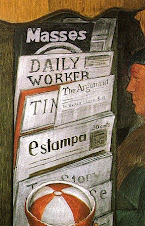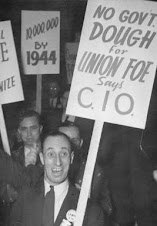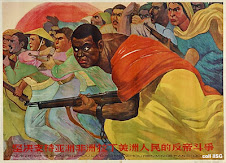The Anti-Cosmopolitan School
The Matrix is just one of a slew films of which it is probably the most famous. These are science films that indirectly attack capitalism. Unlike Social Realism and Proletarian School literature such as Bertolt Brecht, Maxim Gorky, John Steinbeck and such, the Anti-Cosmopolitan (Anti-Cosmo) school does not attack capitalism for poverty, unemployment, greed, and inhumanity. The Anti-Cosmopolitan school attacks capitalism for very unique reasons, forged by the material reality of the era in which they were spawned.

The Anti-Cosmo school attacks capitalism for its false happiness. The real world in The Matrix is of course, a lie. The people of the world think they live in the economically prosperous mid-90s, when in reality they are being harvested like farmed fish or cows raised to be slaughtered.
The same for the main characters in The Island, another hit from this genre. In The Island the protagonists believe they are awaiting a chance to go live in a paradise-like Island after a horrific nuclear holocaust. In reality, they are simply awaiting the day when their bodies will be utilized as replacements, in order to grant immortality to the rich and famous from which they are cloned for this purpose.
The new release Surrogates tells a similar tale. In this futuristic world, people no longer leave their homes and are replaced by robots that they control with their minds. These robots can be who-ever they choose. In reality, the people of the world are overweight, depressed, sad, etc. But in the fantasy world of “surrogates” they can be charming, good like, ideal human beings.
All of these films in the Anti-Cosmopolitan School share several key themes. The Deception of happiness and beauty is a key theme. In the Anti-Cosmopolitan School, all of the heroes think they are in a happy, wealthy, care-free world. In reality, they are suffering horrifically and being exploited. The ugliness of the world is covered for them by the falsehood of happiness.

The Anti-Cosmo School also shows how human beings are reduced to financial calculations. In the Anti-Cosmo School we see how while being deceived into thinking they are in a happy world of love and freedom, the world is really a harsh place in which human beings treat other human beings as chattel, property, and objects to be plundered for personal gain.
The Anti-Cosmo films then share another theme, that being extreme anger and romanticized violence. Upon realizing the false state of reality they inhabit, and breaking through the illusions, the protagonists of these films engage in extreme acts of terroristic and individualist violence.
Who can forget the scene in The Matrix when Neo and his companions enter the corporate offices where those enforcing the deceptions reside, and open fire with thousands of rounds of ammunition from countless fire-arms stuffed under their trench coats. We of course get treated to the humor of our protagonists walking through a metal detector, and hearing the security guard say “Holy Shit!” when he sees the cache of assault weapons and ammunition being carried into the highly protected building calmly, before he is gunned down by the rage filled heroes of the film.
In Surrogates we also get to see a barrage of exploding helicopters, fire-arm duels, explosions, riots, etc. The Island is a bit less violent, but even it contains levels of terrorism, violence, and such.
The Anti-Cosmopolitan School of Science Fiction film is a product of the youth radicals of the late 90s and pre-economic melt-down years of the current decade. It reflects the rage, anger, and confusion of youth drawn to leftist politics in the age of Clinton and Bush.
Bush-Era Radicalism Among Youth
I recall when I was teen, and a “web of lies” had all around me believing they lived in the “happiest, most free country in the world.” The web of lies allowed a large majority of the U.S. to believe that the U.S. was a peace-loving nation, and that the actions of the U.S. abroad were always carried out with the most pure, compassionate, and moral intentions.
Those who realized this to be a falsehood, often through the works of Noam Chomsky and Howard Zinn, the most popular leftist intellectuals at the time, filled with rage. These young people, including myself, saw that the “good America” being spewed before us on T.V. screens and billboards was a lie. We knew that the U.S. was a country that founded itself on mass genocides of indigenous people and slavery.
We knew that the U.S. continues murder and expansionism with economic institutions like the IMF, WTO, and the World Bank, as well as through military imperialistic actions like the destruction of Yugoslavia, the brutal bombing and sanctions of Iraq, the funding of the genocide against Palestine, and the backing, funding, and aid of countless brutal regimes.
The left of the 90s saw itself as “seeing through the matrix.” But no matter how much we tried to tell those around us about this reality, we seemed to continually fall on deaf ears. To the majority of the U.S. population, who got their news from corporate media and capitalist educational institutions, the United States was a peace-loving, democracy spreading, happy, free, fun land of opportunity. When our truth fell on deaf ears, we filled with rage.

Our rage poured out in the Battle of Seattle, where in black hoods and gas masks, countless angry youth from the Columbine Generation fought the police, smashed windows, and spray-painted slogans like “Fuck Capitalism” on the walls of Banks and Starbucks Coffee Shops.
Anarchism gained a huge amount of support among the Bush-era college radicals, and “black blocs” in which youth dressed in black combated police while smashing windows to the rhythm of makeshift drums seemed to pop up at countless demonstrations.
In Cleveland where I currently reside, the Revolutionary Communist Youth Brigade, a youth organization affiliated with the Revolutionary Communist Party, a New Left Maoist Sect, grew in prominence with scores of young recruits from the college wing Anti-War and Anti-Globalization movements.

Chants like: “Saddam, Bin Laden, Pinochet! All Created by the CIA!” sought to break through the Matrix of lies and expose U.S. Imperialism for what it was.
We filled with rage and anger. Some of us undoubtedly watched the violent finale of The Matrix with glee. We were the “good guys” who saw through “the Matrix” and were ready to wage warfare against the heartless machines that ran the world and saw people as objects to be used up and thrown away.
The Smashing of the Matrix
The Anti-Cosmopolitan School of Science Fiction reflected the Bush-era radical’s belief that if people just “had their eyes opened” they could see through the lies and join in revolution.
In some ways we were right. Though George W. Bush was disputably re-elected, he left office in disgrace. His war in Iraq became immensely unpopular. Dislike for torture became the overwhelming public opinion. Dislike and sometimes hatred for Bush and his policies filled nearly all of U.S. society excepting merely a small 22% by the time he left office.
However, the great masses of people in the U.S. didn’t pour their hopes in changing these “moral outrages” into armed revolution or mass protests, though there were many large demonstrations.
Barack Obama’s election campaign was one way that mass outrage against the policies of the Bush-era was channeled. Another way was the road of conspiracism and Neo-fascist Libertarianism.
Documentary films like Loose Change and Zeitgiest traveled the internet, promoting beliefs in a shadowy elite manipulating the world. The audience of Alex Jones, the far-right radio host who believes that Bush is an agent of a secret “socialist conspiracy” also grew in numbers.
Though the country seemed united in its hatred for George W. Bush and the current state of affairs, where to go from there is still not agreed upon. Amidst the confusion, the U.S. economy finally collapsed after years of propping it up with bad lending and government stimulation. The economic meltdown made it clear to all the status quo was no longer an acceptable course to march down. Now new questions had to be answered.
As Lenin Once Asked: “What Is To Be Done?”
In the modern U.S., dislike for the status quo is higher than ever. But what is to be done? Where do we go from here? The “Tea Party Movement”, staffed by former anti-Bushists recruited into the Alex Jones fan club and the Presidential Campaign of John Birch Society supporter Ron Paul, call to “restore the republic.” They seek to revoke all social programs, carry out a mass pogrom against immigrant workers, completely de-regulate the economy, and revert to private control of all features of society.

Then of course, the liberals of the Democratic Party, MSNBC, and Air America seek to make a “kinder, gentler” U.S. society. They seek a national healthcare service, a higher minimum wage, equal rights for the LGBT community, a loosening of the police state, and less religious domination of the affairs of the state.

But all of these forces do not have a political program that can challenge the base of the problem, that being, the capitalist system and its private for-profit control of the economy. Only the Marxist-Leninist movement puts forward a program for a new economic system in which the banks, factories, and other commanding heights of the economy are under the control of the people, and human need comes before the profits of a few.
Yes, the Matrix of lies has been exposed. Now the Emperor stands naked before us, and all see him for what he is. We can clothe him, yes, but what wardrobe it is that shall replace his nudity remains to be written in the pages of history, by the millions of people, who have written every page before, and will be writing many pages still to come.











































No comments:
Post a Comment